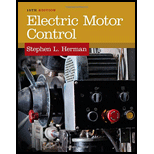
Electric Motor Control
10th Edition
ISBN: 9781133702818
Author: Herman
Publisher: CENGAGE L
expand_more
expand_more
format_list_bulleted
Concept explainers
Question
Chapter 57, Problem 2SQ
To determine
Explain the procedure to obtain the above base speed of a DC motor.
Expert Solution & Answer
Want to see the full answer?
Check out a sample textbook solution
Students have asked these similar questions
Q1. Consider the unity feedback control system whose open-loop
transfer function is:
G(s):
=
40(S+2)
s(s+3)(s+1)(s + 10)
ELECTRIC
Ziegler-Nichols,
By using second method of Ziegler- Nichols, calculate the PID, PI-D and
I-PD parameters and make tuning for this parameters to get accepting
response for the following system, then comp
controllers?
PARTME
then compare your results for all types
GINEARI
I need solution by hand plz
Please solve this circuit using Laplace Transform, show proper solution.
Chapter 57 Solutions
Electric Motor Control
Knowledge Booster
Learn more about
Need a deep-dive on the concept behind this application? Look no further. Learn more about this topic, electrical-engineering and related others by exploring similar questions and additional content below.Similar questions
- Please show step by step solution.arrow_forwardExample 1: There is a transfer function for a second-order system given as follows. 120 G(s)= s²+12s+120 Find 5,,, T, T, T., and %OS.arrow_forward5. Please sketch a root locus manually for the following system. R(s) + E(s) C(s) k(s + 1) s² + 2s +2 Each branch in your root locus must be labeled with an arrow. Please answer the following questions. a. Is the closed-loop system stable as k is varying from 0 to co? Please find an answer to this question via root locus. b. What are finite zeros and poles? Are there infinite zeros? If so, how many?arrow_forward
- -5. Draw the connection diagram for two parallel transformers with (A-A) connected?arrow_forwardHW_#6 HW_06.pdf EE 213-01 Assignments zm Rich LTI uah.instructure.com Z (MAE 272-01) (SP25) DYNAMICS b My Questions | bartleby ✓ Download → Info Page 1 > of 2 - ZOOM + 1) (5 pts) Note have to use nodal analysis at Vp and Vn. a) Determine Vout in the following ideal op-amp circuit. The power supplies supplying power to the op-amp have voltage values of ±15 volts (Vcc = +15 Volts, -VCC = -15Volts) b) Determine the value of RĘ that makes Vo, -15 Volts. c) What value of RF makes Vo = 0 Volts? out F out = 2V 1V 25K 10K 2V 1V 30K 100K RF 12K 12K + E น out E 2) (5 pts) Find Vout in the following circuit. Perform nodal analysis at nodes VN, VP and Va 20K Va 20K 10K 10K 1 V 2 V 5K Vout 15K Note: There is no restriction on the value for Vout for this problem. 3) (5 pts) For the Thevenin equivalent circuit shown, answer the following questions: 250 Ohms a 200 V ° b a) What load resistor results in maximum power delivered to that resistor? b) What is the maximum power delivered to the resistor in…arrow_forwardSuppose the Laplace transform of a causal signal x₁ (t) is given by X₁(s) s+2 s²+1 (a) What is the Fourier transform X₁ (w) of the signal? (b) Using the Laplace transform properties, find the Laplace transform of the following signal x2(t). x2(t) = e³ x₁(t−1)-4x₁(4) Note, you do not need to simplify the expression of X2(s). However, state whether it is possible to write X2(s) as a rational fraction (i.e. ratio of polynomials) in s.arrow_forward
- Consider the following mechanical system. In the figure, y(t) denotes the displacement of the mass from its equilibrium position and u(t) denotes the force applied to the mass. k1 kz - y(t) -0000 0000 3 ► u(t) b a) Find the differential equation model of the system. b) Find the state-space model for the system. Write x, A, B, C and D clearly in your answer.arrow_forwardSee whole documentarrow_forwardC(s) a) Reduce the following system to a single transfer function G(s): R(s) G3(s) R(s) C(s) G1(s) G2(s) G4(s) b) If the input r(t) is a step signal, what will be the output C(s)? Hint: Move the block G₂(s).arrow_forward
- Consider the following electrical system. In the figure, u(t) and y(t) denote the input and output voltages, respectively. Please note that y(t) is the voltage across the resistor. с u(t) +1 y(t) R 0000 a) Find the differential equation model of the system. b) Write the transfer function H(s) = Y(s) of the system. U(s) c) If u(t) = 1 volt, what will be the steady-state output voltage?arrow_forwardQ1: A Moore model sequential network has one input (X) and two outputs (Z2 Z1). An output Z2 = 1 and Z1 =0 occurs every time the input sequence 110 is completed and An output Z2 = 0 and Z1 1 occurs every time the input sequence 010 is completed otherwise Z2 = 0 and Z1 =0. Overlap is not allowed. Use D flip-flops in your design: a) Sketch the state diagram with minimum number of states. b) Construct the state table. = c) Construct the state assigned table. d) Determine the next-state and output logic expressions. e) Sketch the logic circuit.arrow_forwardConsider the following system where two objects are separated by a thermal conductor with thermal resistance R = 1. The temperatures of the objects are denoted by T₁ (t) and T2(t) and their thermal capacities are C₁ = 1 and C2 = 2. Assume, quantities follow their respective SI units. T₁(+) C₁ = 1 12(+) C₂=2 R=1 |T,(0) = 20° -Insulator: no heat flow 5260033500 If the initial temperatures of the two objects are 20°C and 50°C respectively, what will be the steady-state values of the temperatures of these two objects? What is the impact of R in the steady-state value?arrow_forward
arrow_back_ios
SEE MORE QUESTIONS
arrow_forward_ios
Recommended textbooks for you

 Electricity for Refrigeration, Heating, and Air C...Mechanical EngineeringISBN:9781337399128Author:Russell E. SmithPublisher:Cengage Learning
Electricity for Refrigeration, Heating, and Air C...Mechanical EngineeringISBN:9781337399128Author:Russell E. SmithPublisher:Cengage Learning


Electricity for Refrigeration, Heating, and Air C...
Mechanical Engineering
ISBN:9781337399128
Author:Russell E. Smith
Publisher:Cengage Learning